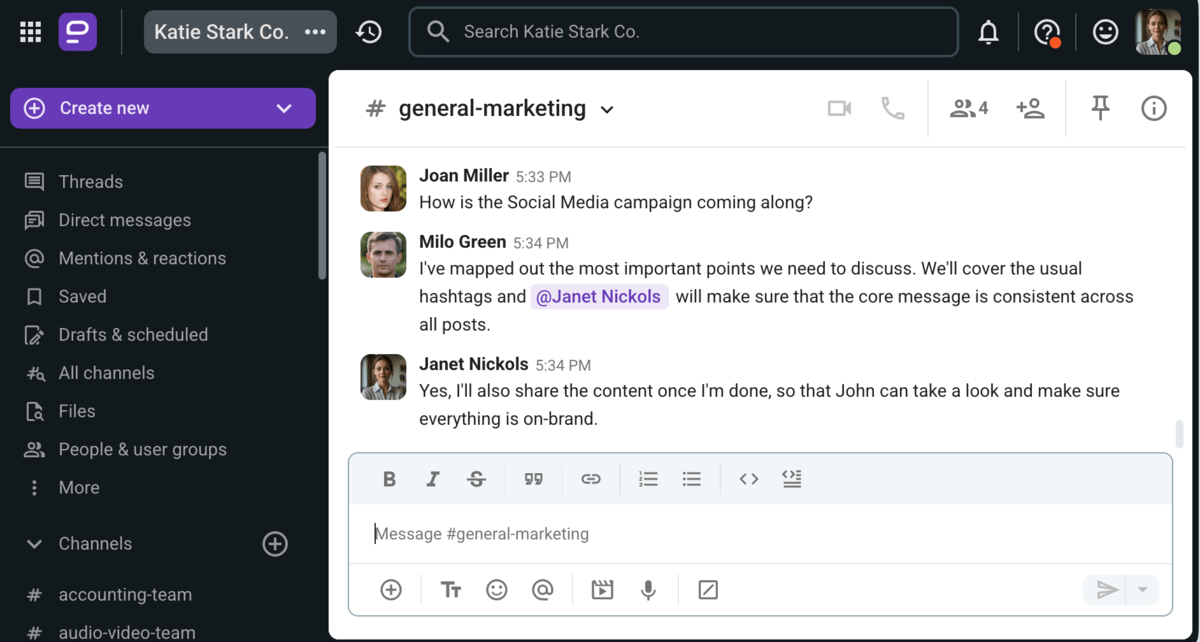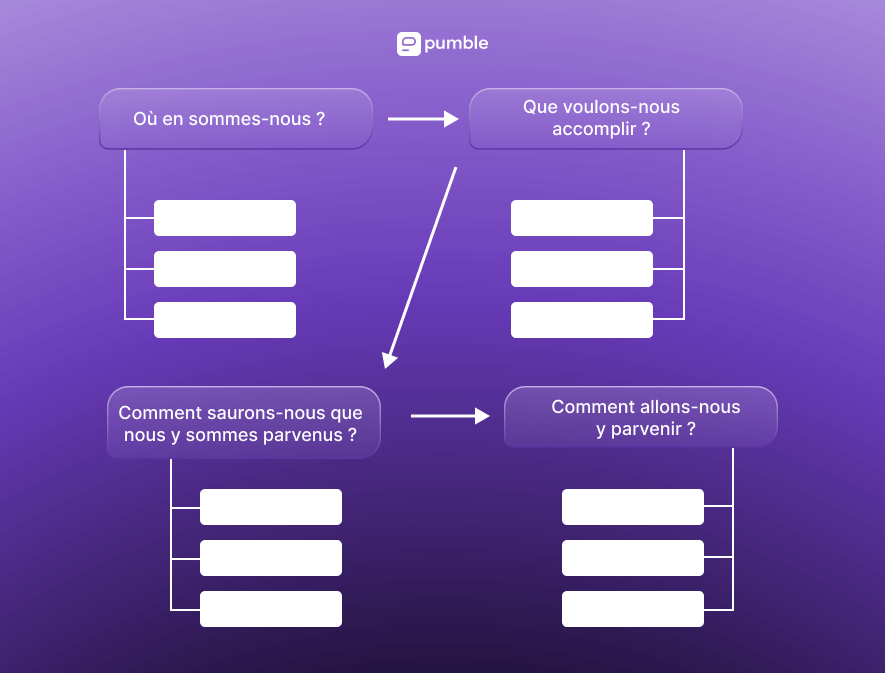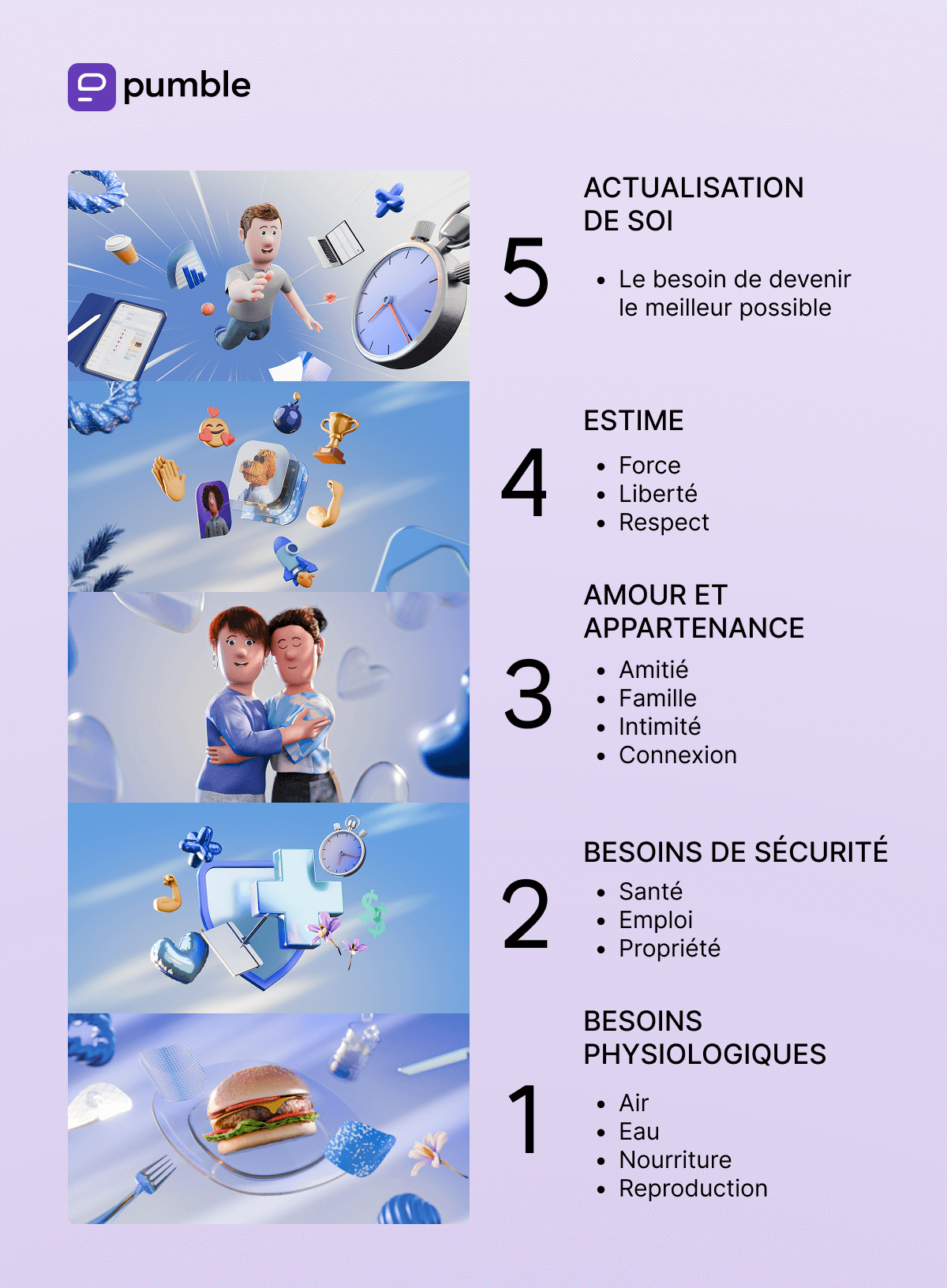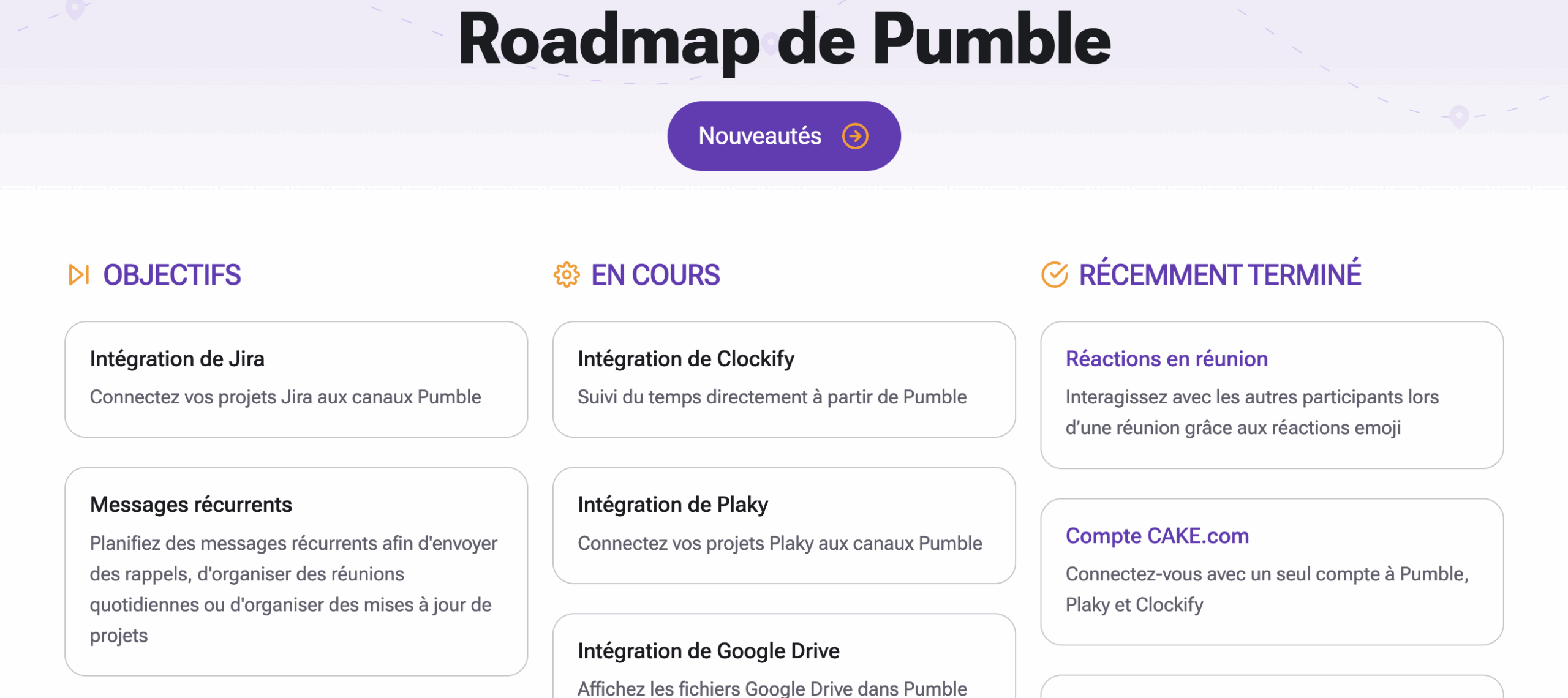Les types de communication sont les différents moyens que nous utilisons pour transmettre des messages à d'autres personnes.
Pour savoir comment communiquer efficacement, vous devez d'abord comprendre quels sont les types de communication dont vous disposez pour transmettre et interpréter vos pensées et vos idées.
Les principaux types de communication que nous pouvons utiliser sont les suivants :
- La communication verbale,
- La communication écrite,
- La communication non verbale et
- La communication visuelle.
Nous verrons comment ces 4 types de communication se subdivisent en plusieurs sous-types et comment ils vous aident à améliorer vos compétences en communication en expliquant en détail ce processus bidirectionnel. Cela vous aidera à transmettre et à interpréter facilement les informations sur le lieu de travail.
Mais avant d'entrer dans le vif du sujet, nous tenions à évoquer deux classifications qui peuvent affecter tout type de communication.
C'est parti !

Communication synchrone ou asynchrone
Avant d'entrer dans les explications détaillées des 4 principaux types de communication, nous devons nous assurer que nous comprenons tous ce que sont les communications synchrones et asynchrones.
L'une des façons de distinguer les types de communication est d'examiner le moment où l'information est communiquée par rapport au moment où elle est reçue. En analysant la communication de cette manière, nous pouvons la classer en deux catégories : synchrone et asynchrone.
Communication synchrone
Si la conversation à laquelle vous participez est synchrone, cela signifie qu'elle se déroule en temps réel.
En d'autres termes, toutes les parties impliquées dans le processus de communication échangent des informations simultanément et à tour de rôle.
Voici quelques exemples de communication synchrone :
- Les réunions en direct — par ex., les membres d'une équipe se réunissant au même endroit pour effectuer une réunion quotidienne,
- Les appels audio — par ex., deux membres d'une équipe discutant de leur projet par téléphone ou via une application de messagerie professionnelle comme Pumble,
- Les appels vidéo — par ex., les membres d'une équipe utilisant une solution virtuelle dotée de fonctionnalités vidéo pour mener à bien leurs réunions quotidiennes, et
- La messagerie instantanée — par ex., deux membres d'une équipe utilisant une application de communication professionnelle pour parler de leur projet en cours.

Améliorez la communication de votre entreprise avec Pumble
Communication asynchrone
Si la conversation dans laquelle vous êtes engagé est asynchrone, les parties impliquées dans l'échange ne participent pas à la conversation au même moment.
C'est un phénomène courant dans les équipes à distance dont les membres travaillent dans des fuseaux horaires différents et ont donc des horaires de travail différents.
Voici quelques exemples notables de communication asynchrone :
- Les vidéos préenregistrées — par ex., une vidéo d'accueil présentée aux nouvelles recrues d'une entreprise.
- Les messages directs ou DM — dans les situations où une personne envoie un message et où l'autre personne y répond plus tard, à sa convenance ou selon sa disponibilité.
- Les messages programmés — les messages rédigés à l'avance et devant arriver à un moment précis.
Maintenant que cette classification de la communication est établie, nous pouvons passer aux quatre principaux types de communication
🎓 Astuce Pro de Pumble
Le professionnel moderne utilise souvent ces deux styles de communication. Pour en savoir plus sur la façon dont les deux coexistent, consultez cet article :
Les 4 principaux types de communication
Comme nous l'avons mentionné, les quatre principaux types de communication sont les suivants :
- La communication verbale,
- La communication écrite,
- La communication non verbale et
- La communication visuelle.
Chacun d'entre eux implique des méthodes de communication différentes et nécessite des compétences de communicationdifférentes.
Nous vous expliquons :
- Les différentes façons d'utiliser efficacement ces types de communication,
- Les conseils pour améliorer votre approche, et
- Les erreurs à éviter pour chacun d'entre eux.
Type n°1 : Communication verbale
Selon la définition d'Andrea McDuffie, titulaire d'un doctorat, avec CCC-SLP (Certificate of Clinical Competence in Speech Language Pathology ), la communication verbale implique toute forme de communication qui utilise le langage parlé comme moyen de partager intentionnellement des informations.
Il s'agit généralement d'un type de communication synchrone. Les locuteurs qui enregistrent leurs messages sous forme d'appels audio ou vidéo et les envoient à d'autres font exception à cette règle. Dans ce cas, nous considérons la communication verbale comme asynchrone.

Il existe de nombreux modèles de communication qui peuvent être utilisés pour disséquer la communication verbale, mais les principaux éléments de ce type d'échange sont les suivants :
- Le message, c'est-à-dire l'information que quelqu'un veut partager,
- L'émetteur, c'est-à-dire la personne qui engage la conversation afin de partager ledit message (en le « codant » de la pensée aux mots prononcés),
- Le récepteur, c'est-à-dire la personne qui a besoin de comprendre ledit message (en le « décodant » des mots entendus à la pensée)
- Le bruit, c'est-à-dire les interférences qui peuvent entraver la communication entre l'émetteur et le récepteur et
- Le feedback, c'est-à-dire la réponse que le récepteur donne à la nouvelle information, en fonction de la manière dont celle-ci a été comprise et interprétée.
Étant donné que la clé de la communication verbale est la langue parlée et que différents pays parlent des langues différentes, la connaissance d'au moins une langue qui n'est pas notre langue maternelle est importante pour la compréhension interculturelle.
Cet aspect est crucial pour les équipes dont les membres parlent des langues différentes. Selon les statistiques de communication sur le lieu de travail de Pumble en 2025, les 10 principales langues commerciales du monde que les professionnels sont le plus susceptibles d'utiliser dans des situations interculturelles (classées en fonction de leur part dans le PIB mondial) sont les suivantes :
- L'anglais, avec une part de 27 %
- Le chinois, avec une part de 18 %
- L'espagnol, avec une part de 8 %
- Le japonais, avec une part de 6 %
- L'allemand, avec une part de 5 %
- Le français, avec une part de 4 %
- L'arabe, avec une part de 3 %
- L'italien, avec une part de 2 %
- Le portugais, avec une part de 2 %
- Le coréen, avec une part de 2 %
Selon le contexte dans lequel la communication verbale est utilisée, il existe différents types de communication verbale. Chacun d'entre eux est utilisé dans des circonstances différentes et nécessite donc une approche légèrement différente.
Types de communication verbale
Il existe 5 grands types de communication verbale :
- La communication intrapersonnelle — les conversations silencieuses que nous avons avec nous-mêmes,
- La communication interpersonnelle individuelle — une conversation en tête-à-tête entre deux personnes,
- La communication en petit groupe — communication interpersonnelle qui se déroule entre plus de deux individus,
- La communication publique — une personne (ou un groupe de personnes) partageant des informations avec un autre groupe de personnes, et
- La communication verbale de masse — le processus d'envoi et de réception de messages audio ou vidéo à travers un média tel que les journaux, la télévision, les émissions de radio, les déclarations des médias sur l'internet, etc.
Chacun de ces types de communication verbale s'accompagne d'un ensemble unique de choses à faire et à ne pas faire.
Tester Pumble pour améliorer la communication de l'équipe
Conseils pour une meilleure communication verbale
Voici un résumé des meilleures pratiques et des choses à éviter pour améliorer votre communication verbale.
| Type de communication verbale | À faire : | À ne pas faire : |
|---|---|---|
| Communication intrapersonnelle | – Pratiquer la conscience de soi – Aiguiser la perception – Pratiquer l'autorégulation | – Ne pas tenir compte de l'équilibre délicat entre la conscience de soi et la perception |
| Communication interpersonnelle individuelle | – Penser à la manière la plus simple de faire passer le message – Être gentil et respectueux – Écouter – Maintenir le contrôle émotionnel | – Sauter d'une pensée à l'autre
– Parler à votre interlocuteur – Prendre les choses personnellement – Se frustrer au premier signe de désaccord |
| Communication en petits groupes | – Réunions quotidiennes – Réunions annuelles du conseil – Utiliser une approche centralisée (déléguer un chef d'équipe) pour les tâches urgentes : bon pour les urgences – Utiliser une approche décentralisée (pas de chef d'équipe) pour une meilleure collaboration à long terme : bon pour le brainstorming et la proposition de solutions créatives. | – Communiquer des informations importantes trop tard – Contribuer à la mentalité en silo |
| Communication publique | – Connaître son public (choisir le vocabulaire et le rythme appropriés) – Être conscient de votre production vocale (pratiquez la clarté, l'intonation, le rythme et le volume) – Utiliser efficacement le langage corporel (établir un bref contact visuel avec les différents membres de l'auditoire, souligner par des gestes les parties importantes de votre présentation) – Planifier du temps pour les questions et les réactions pendant et après la présentation | – Parler trop vite – Ne pas être clair – Marmonner – Être trop nerveux ou stressé |
| Communication verbale de masse | – Être attentif à ce que vous dites
– Choisir le style de présentation approprié – Pratiquer pour dire ce que l'on a à dire | – Manque d'égards envers les mots – Recherche mal l'information avant de la partager |
Type n°2 : Communication écrite
La communication écrite consiste à transmettre ses pensées, ses idées, ses questions et ses préoccupations au moyen de symboles, c'est-à-dire de lettres qui forment des mots, des expressions et des phrases.
Comme la plupart des autres types de communication, la communication écrite peut être synchrone ou asynchrone.

D'une manière générale, on peut distinguer 3 types de communication écrite :
- La communication écrite transactionnelle, qui consiste en des messages nécessitant une réponse de la part du destinataire. Il peut s'agir d'une demande de service, d'une demande de rendez-vous ou d'un besoin de clarification avant d'entreprendre une tâche.
- La communication écrite informative, qui existe pour le bénéfice du destinataire. Elle peut prendre la forme d'un mémo sur les nouvelles politiques de l'entreprise, d'une notification sur l'ordre du jour de la prochaine réunion ou d'un rapport sur les performances d'un service de l'entreprise.
- La communication écrite pédagogique, qui comprend les messages envoyés dans le but de fournir des instructions au destinataire. Il peut s'agir de clarifier les détails du projet confié à un membre de l'équipe ou d'offrir des instructions étape par étape pour un nouveau type de tâche.
Chacun des types de communication écrite énumérés peut se manifester sous la forme de :
- Emails — le moyen traditionnel de la communication d'entreprise,
- Messages instantanés — les transmissions de texte en temps réel qui sont beaucoup plus efficaces que les emails,
- Rapports — comptes rendus sur une question particulière, généralement sous la forme de documents officiels,
- Formulaires — un document structuré pour répondre à des questions destinées à accélérer le processus de collecte de diverses informations,
- Lettres — pour les entreprises, aujourd'hui typiquement requises uniquement dans des situations très spécifiques,
- Mémorandums — un document destiné à informer le public de nouveaux développements (il peut également comporter des éléments de persuasion et un appel à l'action),
- Bulletins — une brève déclaration officielle, annonce ou résumé des dernières nouvelles d'une organisation, généralement à usage interne, et
- Newsletters — une forme de communication écrite semblable à un journal télévisé qui présente des mises à jour sur les progrès accomplis et des déclarations officielles, avec des éléments facultatifs de persuasion du client.
Afin de trouver la clé d'une communication écrite plus efficace, examinons les principes de base et les meilleures pratiques de ces supports.
Conseils pour une meilleure communication écrite
Découvrez ici ce qu'il faut rechercher et ce qu'il faut éviter dans la communication écrite.
| Moyen de communication écrite | À faire : | À ne pas faire : |
|---|---|---|
| Emails | – Avoir une ligne d'objet claire – Être précis et concis –Avoir un ton du message professionnel mais chaleureux – Relire | – Être flou – Être insensible – Écrire dans un style inapproprié |
| Messages instantanés | – Être concis – Respectez le temps des destinataires (vérifiez leur statut et leur disponibilité) – Garder les conversations informelles en dehors des canaux formels | – Faire traîner la conversation trop longtemps – Diviser un message long en plusieurs messages distincts (quelques messages distincts suffisent) |
| Rapports | – Utiliser un langage clair – Utiliser un plan claire – Réviser avant l'envoi | – Utiliser une structure de document inadaptée – Faire des erreurs, surtout si vous incluez des chiffres |
| Formulaires | – Ne demander que les informations essentielles – Utiliser des étiquettes claires et concises – Utiliser des barres de progression pour les formulaires longs | – Inclure trop de champs facultatifs – Rendre le formulaire trop long et fastidieux |
| Lettres | – Trouver le format adapté à votre situation – Rester concis – Être direct | – Adresser la lettre de manière inappropriée – Faire des fautes de grammaire et d'orthographe |
| Mémorandums | – Maintenir simples – Utiliser des listes numérotées et à puces – Utiliser le style visuel préféré de votre organisation | – Inclure trop d'informations – Utiliser le mauvais ton |
| Bulletins | – Le contenu doit être concis et facile à lire – Mettez les informations clés dans la ligne d'ouverture – Vérifier deux fois toutes les informations | – Rendre trop longues – Inclure l'information peu claire |
| Newsletters | – Garder un ton léger – Essayer de les personnaliser | – Rendre les newsletters trop formelles – Envoyer les newsletters trop fréquemment |
Type n°3 : Communication non verbale
La communication non verbale fait référence à des schémas non verbaux, tels que les gestes, les expressions faciales, la posture du corps et d'autres mouvements que nous utilisons pour transmettre des informations sans utiliser de mots.

La communication non verbale est généralement synchrone.
Et si nous regardons une présentation vidéo préalablement enregistrée d'un orateur qui montre également ses signaux non verbaux ? Dans ce cas, la transmission serait qualifiée d'asynchrone.
Quoi qu'il en soit, lorsque nos interlocuteurs peuvent nous voir, la communication non verbale peut ajouter un autre niveau de signification à la conversation.
Bien entendu, nous n'avons pas toujours l'intention de transmettre ces informations supplémentaires. En fait, parfois, même cette communication subconsciente peut être trompeuse d'une certaine manière.
Cela dit, examinons individuellement les différents aspects de la communication non verbale, tels que :
- Posture du corps — la façon dont une personne s'assoit, marche, se tient debout ou positionne son corps d'une autre manière,
- Poignées de main — un élément essentiel de la première impression,
- Expressions faciales — permettant de communiquer rapidement ses sentiments immédiats,
- Paralinguistique — la communication vocale distincte du langage proprement dit (hauteur, ton et inflexion),
- Gestes — les mouvements de la tête, du visage ou d'autres parties du corps qui peuvent communiquer des messages spécifiques (souvent propres à une culture),
- Proxémique — l'interprétation des attitudes des personnes en fonction de leur maîtrise de l'espace physique et de leur proximité,
- Haptique — la communication non verbale transmise par le toucher,
- Oculosique — la communication non verbale qui implique des mouvements des yeux et d'autres types de comportements oculaires qui peuvent être interprétés comme un moyen de communication,
- Apparence — la communication non verbale qui peut donner un sens supplémentaire à une conversation, et
- Artefacts — la communication non verbale qui implique des objets, des images et d'autres outils que vous pouvez utiliser pour communiquer (uniformes, photos de profil, vêtements indiquant des professions, etc.)
Conseils pour une meilleure communication non verbale
Voyons ce qu'il faut faire et ne pas faire pour améliorer la partie non verbale de votre communication.
| Type de communication non verbale | À faire : | À ne pas faire : |
|---|---|---|
| Posture du corps | – Maintenir une posture ouverte (tournée vers l'interlocuteur, bras détendus et jambes non croisées) – Utiliser la technique du miroir | – Exagérer ou forcer la technique du miroir (cela conduit facilement à des situations embarrassantes |
| Poignées de main | – Trouver un juste milieu entre trop ferme et trop lâche – Maintenir le contact visuel et sourire poliment – Garder une distance respectable | – Serrer la main trop mollement ou trop fermement – Tenir la main de l'autre personne trop longtemps (1 à 2 secondes suffisent généralement) – Se tenir trop près ou trop loin |
| Expressions faciales | – Sourire – Relâcher le front | – Exagérer les expressions faciales – Froncer les sourcils par inadvertance |
| Gestes | – Refléter les expressions de l'autre personne pour montrer de l'empathie et de la compassion – Utiliser les gestes de la main pour souligner les points – Explorer les différences culturelles en matière de gestes | – Faire les gestes dont vous n'êtes pas sûr – Assumer des gestes « universels » sans se familiariser avec la culture de votre interlocuteur |
| Paralinguistique | – Ajuster le volume de votre voix – Varier votre intonation pour éviter de paraître monotone – Articuler chaque mot clairement | – Se précipiter et marmonner – Parler trop longtemps sur une seule intonation |
| Proxémique | – Ne vous tenez pas à moins d'un mètre de votre interlocuteur | – Envahir l'espace personnel d'une personne |
| Haptique | – Savoir ce qui est considéré comme inapproprié – Apprendre sur la culture locale et la culture de l'entreprise et s'adapter en conséquence | – Établir un contact physique si vous n'êtes pas sûr de vous |
| Oculosique | – Maintenir un contact visuel constant – Maintenir le contact visuel, mais essayer de ne pas le fixer trop longtemps | – Maintenir le contact visuel, mais essayer de ne pas le fixer trop longtemps |
| Apparence | – Prendre soin de son hygiène personnelle – Respecter le code vestimentaire | – Enfreindre délibérément les règles du code vestimentaire |
| Artéfacts | – Garder une apparence professionnelle cohérente sur le plan stylistique (comme les photos de profil sur les comptes de réseaux sociaux professionnels) | – Être incohérent et communiquer des messages contradictoires |
Type n°4 : Communication visuelle
Selon la définition, la communication visuelle est le processus de transmission d'informations par le biais d'éléments visuels.
Ce type de communication peut consister en des images telles que des photographies ou des illustrations, des visualisations de données telles que des tableaux et des graphiques, et d'autres éléments visuels similaires qui aident à transmettre notre sens.

Comme beaucoup d'autres types de communication, la communication visuelle peut être synchrone ou asynchrone.
La communication visuelle est pratique et souvent beaucoup plus facile à traiter que d'autres types de communication. En fait, selon les scientifiques, le fait d'associer des éléments visuels à une information peut augmenter l'apprentissage d'un pourcentage stupéfiant de 400 %.
Les éléments et les outils de communication visuelle que nous pouvons utiliser sur le lieu de travail sont les suivants :
- Images — l'un des outils visuels les plus applicables,
- Vidéos — dans le monde des affaires, généralement utilisées pour créer une narration autour d'un point,
- Organigrammes — un type de diagramme qui décrit un flux de travail ou un processus,
- Roadmaps — plans stratégiques visuels destinés à vous aider à atteindre un objectif commercial particulier,
- Graphiques de données — diverses représentations graphiques de données (telles que les diagrammes à barres, les diagrammes linéaires, les diagrammes de surface, les diagrammes circulaires ou les diagrammes en beignet),
- Infographies — une combinaison de divers éléments visuels utilisés pour expliquer des concepts, présenter des statistiques, énumérer des conseils, expliquer des dates importantes, etc.,
- Diapositives de présentation — contenant idéalement une quantité modérée d'éléments divers, tels que du texte, des diagrammes, des graphiques, des images et d'autres représentations visuelles de données,
- Rapports visuels — les comptes rendus sur un sujet particulier comprenant des améliorations visuelles, qui facilitent la lecture et la compréhension des éléments textuels,
- Cartes mentales — les outils de visualisation axés sur un sujet central, qui se subdivise en sous-thèmes et en idées connexes, utilisés pour représenter les processus de réflexion dans le cadre de stratégies commerciales, de la gestion de projets ou de rapports, et
- Imprimées — les documents papier contenant des informations clés, généralement sous la forme de dépliants, de brochures et d'affiches, souvent utilisés comme éléments d'accompagnement d'une présentation ou d'un argumentaire.
Principaux avantages d'une bonne communication visuelle
Examinons les principaux avantages d'une meilleure communication visuelle.
Avantage n°1 : Les visuels rendent les données techniques plus intéressantes
Si vous avez besoin de faire une présentation sur un sujet sec et technique, embellissez-la en utilisant des diapositives de présentation, des graphiques et des infographies colorés.
Organiser les données de cette manière permettra au public de s'engager plus facilement.
Avantage n°2 : Les éléments visuels peuvent simplifier les idées abstraites
À l’instar du conseil précédent, les éléments visuels peuvent également faciliter l’explication des concepts abstraits dont vous pourriez avoir besoin de discuter.
Par exemple, lorsque vous essayez d'expliquer un processus complexe, vous pouvez utiliser un organigramme ou une feuille de route pour aider le public à le comprendre.
Alternativement, lorsque vous discutez d’idées de conception, une illustration ou une photographie expliquerait naturellement vos idées mieux que des mots.
Avantage n°3 : L'approche « montrer, ne pas dire » est la plus efficace
En fin de compte, les éléments visuels sont un outil utile pour montrer le fonctionnement des choses.
Par exemple, si votre équipe utilise Pumble et que vous souhaitez expliquer à un nouvel employé comment il fonctionne, il est préférable de lui montrer une démo où il pourra voir son utilisation en action.
Avantage n°4 : Les visuels définissent votre marque
Si vous présentez souvent des données à l’aide de visuels, vous souhaiterez peut-être établir une certaine cohérence stylistique dans vos supports.
Si vous n’êtes pas auto-entrepreneur, vous utiliserez les atouts de la marque de votre organisation, y compris ses couleurs primaires et d’autres éléments de conception.
Cependant, si vous êtes auto-entrepreneur, vous souhaiterez peut-être créer vos propres actifs de marque. Cela devrait vous aider à créer une expérience visuelle cohérente pour le public.
Avantage n°5 : La psychologie des couleurs peut affecter votre public à un niveau plus profond
Les designers utilisent souvent la psychologie des couleurs pour faire appel au subconscient. Par exemple, avez-vous déjà remarqué que les logos des entreprises technologiques ont tendance à être bleus et que les marques alimentaires misent sur le rouge ?
C'est parce que ces couleurs sont associées à des concepts que ces entreprises tentent d’incarner.
D'une part, la couleur bleue représenterait la notion de sécurité et de fiabilité – deux idées auxquelles toute entreprise technologique aimerait être associée.
D'un autre côté, la couleur rouge est connue pour attirer l'attention en raison de son association avec l'énergie, la passion et même l'mpulsivité. Comme vous pouvez l'imaginer, les entreprises du secteur alimentaire feraient tout pour stimuler l'appétit et l'impulsivité du public.
Là encore, la couleur rouge ne symbolise pas la même chose partout dans le monde – et les autres teintes non plus.
Il suffit de dire que vous devrez savoir qui est votre public avant de commencer à appliquer les principes de la psychologie des couleurs.
Exemples de méthodes de communication visuelle
Examinons quelques exemples notables d'outils de communication visuelle utilisés avec succès par différents types d'entreprises.
Exemple de graphique de données
Les graphiques de données peuvent prendre différentes formes, en fonction du type de données que l'on souhaite représenter.
Dans l'exemple ci-dessous, le rédacteur du blog Fun facts and statistics about time zones utilise le logiciel de collaboration d'équipe Pumble pour envoyer à l'illustrateur du blog un diagramme circulaire montrant les 24 fuseaux horaires et le nombre de pays que chacun d'entre eux englobe.
Le rédacteur souhaite que le diagramme à secteurs serve d'image de référence et d'inspiration à l'illustrateur du blog afin qu'il puisse recréer un diagramme à secteurs similaire pour son article de blog.

Exemple d'organigramme
Lors de la création d'un organigramme, on utilise souvent des boîtes pour représenter les différentes étapes d'un processus. Les cases, c'est-à-dire les étapes, sont généralement reliées entre elles par des flèches ou des lignes.
Dans l'exemple suivant, un spécialiste junior de l'acquisition de talents au sein d'une équipe de RH est chargé de planifier des améliorations dans le processus de recrutement.
Elle planifie ces améliorations à l'aide d'un organigramme qui comprend les cases connectées suivantes :
- « Où en sommes-nous ? »
- « Que voulons-nous accomplir ? »
- « Comment allons-nous y parvenir ? »
- « Comment saurons-nous que nous y sommes parvenus ? »

Exemple d'infographie
Les infographies sont un outil utile pour présenter des statistiques, expliquer des concepts, décrire un processus, comparer des produits ou organiser des informations de manière simple, mais aussi visuellement attrayante.
Dans l'exemple suivant, un psychologue scolaire crée une infographie sur le thème de la motivation qui résume diverses théories de motivation pertinentes (telles que la hiérarchie des besoins de Maslow).
Ils l'accrochent au mur de la salle des professeurs pour aider leurs collègues enseignants à maintenir un niveau de motivation élevé tout au long de leur travail.

Exemple de diapositive de présentation
En règle générale, le présentateur, ou un membre de son équipe, commencera le processus de création d'une présentation en compilant les informations qu'il souhaite transmettre.
Ensuite, ils utiliseraient ces données pour créer des diapositives composées d'une quantité modérée de texte, de diagrammes, de tableaux, d'images et d'autres représentations visuelles de données.
Étant donné que les présentations sont une méthode assez courante de transmission d'informations sur le lieu de travail moderne, de nombreuses entreprises proposent des modèles de marque à la disposition des employés qui sont souvent appelés à faire des présentations.
Même si ce n'est pas obligatoire, la plupart des présentations se terminent par des références, des « remerciements », des coups de projecteur et des appels à l'action.

Exemple de roadmap
Les roadmaps indiquent les étapes à franchir et les jalons à atteindre pour que vos efforts soient couronnés de succès. Elle présente le chemin parcouru depuis les étapes de planification jusqu'au lancement réussi de l'application que vous êtes en train de développer.
Dans notre exemple, nous présentons le roadmap publique de Pumble, qui permet aux clients d'être informés des mises à jour des produits de Pumble.

Définissez et réalisez vos buts pro avec Pumble
Conseils pour une meilleure communication visuelle
Pour conclure ce chapitre, examinons ce qu'il faut faire et ne pas faire pour les différents moyens de communication visuelle.
| Méthodes de communication visuelle : | À faire : | À ne pa faire : |
|---|---|---|
| Images | – Choisir le style et le format appropriés
– Choisir la bonne palette de couleurs | – Surcharger vos présentations avec trop d'images (elles perdront de leur importance) |
| Vidéos | – Adapter leur longueur selon le contexte (présentation d'entreprise, vidéo éducative, court documentaire indépendant, etc.) – Rendre les vidéos dynamiques et intéressantes | – Les rendre trop longues – Créer des vidéos dans un format inadapté à votre application |
| Graphiques de données | – Rendre les choses faciles à saisir – Visuellement attrayant et conforme à votre entreprise ou à votre équipe | – Être difficile à lire – Inclure trop de données |
| Organigrammes | – Se concentrer sur les étapes les plus importantes que vous souhaitez mettre en évidence – Donner des titres et des descriptions courts et efficaces | – Inclure trop d'étapes
– Inclure trop de lignes de texte |
| Roadmaps | – Séparer les étapes à venir de celles qui viennent d'être terminées ou de celles qui sont à l'état d'idée – Décrire les étapes brièvement et efficacement | – Rendre le visuel confus – Décrire les étapes de manière trop détaillée |
| Cartes mentales | – Créer un sujet central clair – Créer des branches en fonction du processus de réflexion ou de la pertinence par rapport au sujet central | – Oublier le sujet central – Enchaîner arbitrairement des termes sans trop réfléchir |
| Infographies | – Résumer brièvement des informations importantes – Choisir la composition appropriée pour le visuel | – Inclure trop ou trop peu de détails – Créer un visuel déséquilibré (trop de texte ou trop d'éléments visuels) |
| Diapositives de présentation | – Considérer votre présentation comme un équilibre subtil entre les éléments écrits, montrés et parlés | – Rendre les phrases des diapositives plus longues que nécessaire – Surcharger vos diapositives avec de nombreux éléments |
| Rapports visuels | – Inclure des améliorations visuelles (couleur de surbrillance, blocs de couleur, autres motifs visuels) – Créer une hiérarchie de texte claire pour faciliter la navigation | – Surcharger d'éléments de conception inutiles – Utiliser des polices informelles |
| Imprimés | – Inclure des informations supplémentaires ayant une valeur unique dans le contexte | – Répéter les mêmes informations |
Autres types de communication
Après avoir abordé les quatre grands types de communication, examinons les autres formes de communication et comprenons leurs différences.
Communication en ligne ou hors ligne
Avec l'émergence d'Internet et des différentes technologies qui l'accompagnent, une autre classification majeure de la façon dont nous communiquons est apparue : la communication en ligne et la communication hors ligne.
Aujourd'hui, la plupart des gens communiquent et tissent des liens sociaux en combinant ces deux modes de communication.
Cependant, les implications d'un tel modèle de communication mixte sur nos interactions sociales ne sont pas encore totalement comprises.
Selon les statistiques de Pumble sur le travail à distance en 2025, près de 46 % des chefs de projet interrogés ont cité le manque de communication comme le plus grand défi à relever dans la gestion du travail à distance.
Dans une autre enquête, 71 % des personnes interrogées ont reconnu que l'établissement et le maintien de relations constituaient l'un des plus grands défis pour les équipes virtuelles.
Cependant, les modèles de communication mixtes présentent également de nombreux aspects positifs.
Avantages de la communication en ligne sur le lieu de travail
Même si la communication en ligne peut avoir un effet perturbateur sur les relations personnelles, sur le lieu de travail, les outils de communication en ligne peuvent considérablement améliorer la communication au sein d'une organisation.
Les nouvelles technologies ont simplifié le processus d'échange d'informations avec les clients et les tiers. Selon les statistiques sur le travail à distance, 98 % des personnes interrogées ont déclaré qu'elles travailleraient à distance, au moins une partie du temps, pendant le reste de leur carrière professionnelle.
Une autre statistique souligne que les 4 avantages les plus courants pour les employés de la génération Z et du millénaire qui travaillent à distance sont les suivants :
- Un meilleur équilibre entre vie professionnelle et vie privée,
- L'économie d'argent,
- Une meilleure productivité, et
- L'impact positif sur la santé mentale.
La communication en ligne présente d'autres avantages notables :
- Communication asynchrone beaucoup plus facile à travers différents fuseaux horaires,
- Rappel et transcription de réunions virtuelles, et
- Assignation de processus beaucoup plus efficacement et à plusieurs membres de l'équipe en même temps.
Voici un exemple de communication asynchrone réussie dans Pumble :

Simplifier la communication de l'équipe avec Pumble
Types de communication selon la hiérarchie
Après avoir exposé les différents types de communication auxquels nous pouvons être confrontés, ainsi que les réponses appropriées qu'ils appellent, il est temps d'examiner la manière dont nos relations professionnelles avec nos interlocuteurs influencent nos échanges.
De ce point de vue, il existe quatre types de communication professionnelle :
- La communication ascendante — les subordonnés communiquent avec leurs supérieurs. Elle se réfère à la fois à la communication individuelle et au sentiment général parmi les employés. Elle s'appuie souvent sur des formulaires, des enquêtes, des rapports et d'autres méthodes similaires de transmission de l'information.
- La communication descendante — les supérieurs communiquent avec leurs subordonnés. Elle est principalement utilisée pour transmettre de nouvelles informations, donner des instructions, déléguer des tâches, etc.
- La communication latérale — échanges entre des employés ou des services de même rang ou de même statut. Elle peut se faire en tête-à-tête ou en groupe, à l'oral ou à l'écrit.
- La communication externe — une organisation qui communique avec des parties externes, telles que les clients, les partenaires, les vendeurs, les fournisseurs, les entités juridiques, les médias et le grand public. Ce type de communication nécessite un examen attentif de tout malentendu potentiel, qu'il s'agisse d'une annonce, d'une publicité ou d'un autre type de message externe.
🎓 Astuce Pro de Pumble
Pour que la communication externe soit réussie, une organisation doit d’abord établir une communication interne impeccable. Si vous trouvez cela difficile à réaliser, vous pouvez consulter l’article suivant :
Utilisez différents types de communication avec Pumble
L'exploration des différents types de communication dévoile la vaste gamme d'outils et de plateformes à votre disposition. Des interactions en face à face avec la messagerie asynchrone, interactions to asynchronous messaging, les différentes formes de communication offrent des avantages uniques et répondent à des besoins et des préférences différents.
Lorsque vous naviguez dans ce paysage diversifié, il est essentiel d'intégrer des outils de messagerie tels que Pumble.
Pumble est une application de communication d'équipe qui favorise une collaboration transparente entre les membres de l'équipe.
Qu'il s'agisse d'un brainstorming ou d'une correspondance sur des tâches partagées, Pumble facilite les flux de communication efficaces, agissant comme un QG numérique pour vous et votre équipe.
Utilisez ses messages directs, ses canaux privés et publics, le partage de fichiers, les appels vidéo, et bien plus encore, pour peaufiner tous les types de communication que vous utilisez dans votre travail.
Améliorez la productivité et la collaboration et, en fin de compte, améliorez vos efforts de communication efficaces.
Découvrez comment Pumble peut améliorer la communication de votre équipe -
Testez Pumble de CAKE.com dès aujourd'hui
Comment nous examinons cet article : Nos rédacteurs et éditeurs vérifient les articles et les mettent à jour lorsque de nouvelles informations sont disponibles, afin qu'ils soient toujours d'actualité.


